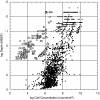Subseafloor sedimentary life in the South Pacific Gyre
- PMID: 19561304
- PMCID: PMC2702254
- DOI: 10.1073/pnas.0811793106
Subseafloor sedimentary life in the South Pacific Gyre
Abstract
The low-productivity South Pacific Gyre (SPG) is Earth's largest oceanic province. Its sediment accumulates extraordinarily slowly (0.1-1 m per million years). This sediment contains a living community that is characterized by very low biomass and very low metabolic activity. At every depth in cored SPG sediment, mean cell abundances are 3 to 4 orders of magnitude lower than at the same depths in all previously explored subseafloor communities. The net rate of respiration by the subseafloor sedimentary community at each SPG site is 1 to 3 orders of magnitude lower than the rates at previously explored sites. Because of the low respiration rates and the thinness of the sediment, interstitial waters are oxic throughout the sediment column in most of this region. Consequently, the sedimentary community of the SPG is predominantly aerobic, unlike previously explored subseafloor communities. Generation of H(2) by radiolysis of water is a significant electron-donor source for this community. The per-cell respiration rates of this community are about 2 orders of magnitude higher (in oxidation/reduction equivalents) than in previously explored anaerobic subseafloor communities. Respiration rates and cell concentrations in subseafloor sediment throughout almost half of the world ocean may approach those in SPG sediment.
Conflict of interest statement
The authors declare no conflict of interest.
Figures



References
-
- Whelan J, et al. Evidence for sulfate-reducing and methane-producing microorganisms in sediments from Sites 618, 619, and 622. In: Bouma AH, et al., editors. Initial Reports Deep Sea Drilling Project 96. Washington: U.S. Government Printing Office; 1986. pp. 767–775.
-
- Parkes RJ, Cragg BA, Wellsbury P. Recent studies on bacterial populations and processes in subseafloor sediments: A review. Hydrogeology J. 2000;8:11–28.
-
- D'Hondt S, et al. Distributions of microbial activities in deep subseafloor sediments. Science. 2004;306:2216–2221. - PubMed
-
- Jørgensen BB, D'Hondt SL, Miller DJ. Leg 201 synthesis: Controls on microbial communities in deeply buried sediments. In: Jørgensen BB, D'Hondt SL, Miller DJ, editors. Proceedings Ocean Drilling Program, Scientific Results, 201; College Station, TX: Ocean Drilling Program; 2006. pp. 1–45.
-
- Jahnke RA. The global ocean flux of particulate organic carbon: Areal distribution and magnitude. Global Biogeochem Cycles. 1996;10:71–88.
Publication types
MeSH terms
Substances
LinkOut - more resources
Full Text Sources

